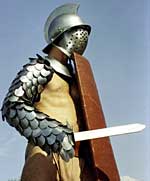The Real Spartacus

The popular image of Spartacus seems like a real-life version of David and Goliath. In the first century BC, a slave named Spartacus threatened the power of Rome. Under his leadership, a tiny band of gladiators grew into a vast revolutionary army. About 100,000 men followed him, keeping faith until the last; only the full force of the Roman army could crush the revolt. Its memory lives on, a symbol of the power of free people to confront tyranny.
The real story of Spartacus is far more complex than this familiar, heroic image: a story of a real and fallible person in a culture very different from our own. It remains an inspiring story for all that.
Slaves and fighters
In Spartacus's time, the Roman republic was entering a period of turmoil which would end with the rule of the Caesars. Roman territories were expanding east and west; ambitious generals could make a name fighting in Spain or Macedonia, then carve out a political career in Rome. Rome was a militaristic society: battles were staged in the newly popular sport of gladiatorial combat. While successful gladiators were idolised, in terms of social status they ranked little above convicts; indeed, some gladiators were convicted criminals.
Others were slaves. Slavery accounted for roughly every third person in Italy. Slaves were liable to extreme and arbitrary punishment from their owners; while the death penalty for free Romans was rarely invoked (and humanely executed), slaves were routinely crucified. In the previous century, two slave revolts, both on Sicily, had been put down at the cost of tens of thousands of lives.
Gladiators and rebels
Spartacus was a native of Thrace (now Bulgaria). After joining the Roman invaders as a mercenary, he was enslaved and sold at auction to a trainer of gladiators in Capua. In 73BC, Spartacus led a revolt of 74 gladiators, who escaped and fled to the slopes of Mount Vesuvius, where they set up camp.
Rome's response was swift and forceful: an army of 3,000 was sent to suppress the rebellion. Meanwhile, Spartacus's camp had become a magnet for slaves from the surrounding area, several thousand of whom joined him. In an impressive tactical coup, he defeated the Roman army by abseiling his forces down the side of the mountain and attacking from behind. A second army was sent out, numbering 6,000 and bearing the fasces, the symbol of Roman authority. This too was defeated. Spartacus captured the symbolic fasces.
Spartacus's army spent the winter of 73BC camped on the south coast of Italy, building up its armaments and morale. In spring, it headed north; the audacious plan was to march the length of Italy, cross the Alps and escape to Gaul (present-day France, then largely outside Roman control). Two armies were sent to intercept it, and both were defeated.
But Rome scored one victory, defeating a Gaulish contingent which had refused to march under Spartacus's leadership; 20,000 Gauls were killed. In honour of the Gaulish leader Crixus, Spartacus held funeral games, including gladiatorial combat between captured Roman soldiers.
Winners and losers
At Mutina (Modena), Spartacus faced his greatest challenge: an army of two legions – 10,000 men – commanded by Cassius Longinus, the Governor of Cisalpine Gaul (Piedmonte). The army was massacred; Spartacus seemed invincible.
Then the plan changed. Perhaps drawn by Italian plunder, perhaps put off by the logistics of getting an army across the Alps, Spartacus turned back: his army once more marched the length of Italy, repulsing an attack by two legions under the command of Licinius Crassus. By the end of 72BC, the army was encamped in the south, this time at Rhegium (Reggio Calabria) on the Strait of Messina: a few kilometres from Sicily, homeland of the previous slave revolts.
But events were no longer moving Spartacus's way. Crassus, a wealthy and ambitious Roman politician, built up his forces. For reasons which are unclear, Spartacus proved no more able to cross the Strait of Messina than the Alps. Seeing Spartacus trapped, Crassus built fortifications, which contained the rebels in the peninsula.
After a small skirmish, Spartacus had a Roman prisoner crucified. This new transgression was the final provocation. Two Roman generals were recalled, Pompey from Spain and Lucullus from northern Turkey. Spartacus carried out one final coup, breaching Crassus's impregnable wall and making for the port of Brundisium (Brindisi), where Lucullus's army was landing. In the event, Spartacus's army was intercepted and trounced by Crassus.
Myth and reality
Contrary to the celebrated sequence in Stanley Kubrick's 1960 film, Spartacus, the survivors of the battle were never asked to identify Spartacus; he had died on the battlefield. The subsequent mass crucifixion scene, however, is historically accurate: Crassus had 6,000 men crucified along the Appian Way between Capua and Rome – a distance of about 200 kilometres.
Spartacus was a brilliant battlefield tactician with an eye for the defiant gesture. But he was not, as Spartacus presented him, the revolutionary leader of a disciplined fighting force. He never posed any threat to the Roman order; it would be unthinkable for any Romans to ally with a band of slaves, as Spartacus suggested. Little united his army except the goal of continuing survival; internal dissent and sheer confusion sealed its fate as surely as Rome’s superior forces.
Nevertheless, the legend of Spartacus lived on. For the Romans, the story of the slave revolt was an awful warning: it suggested that a society built on the backs of slaves and subject peoples might one day be overthrown by them. Four centuries later, this is exactly what happened, and Rome fell to the 'Barbarians'.

0 Comments:
Post a Comment
<< Home